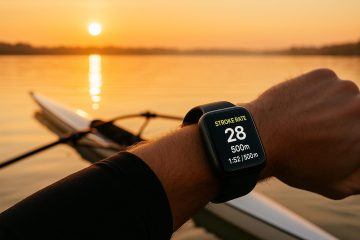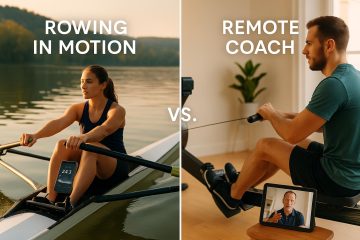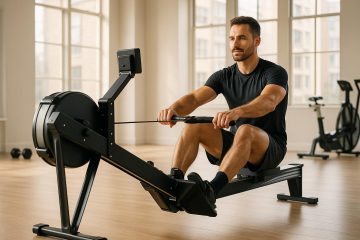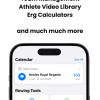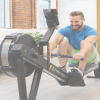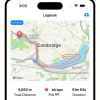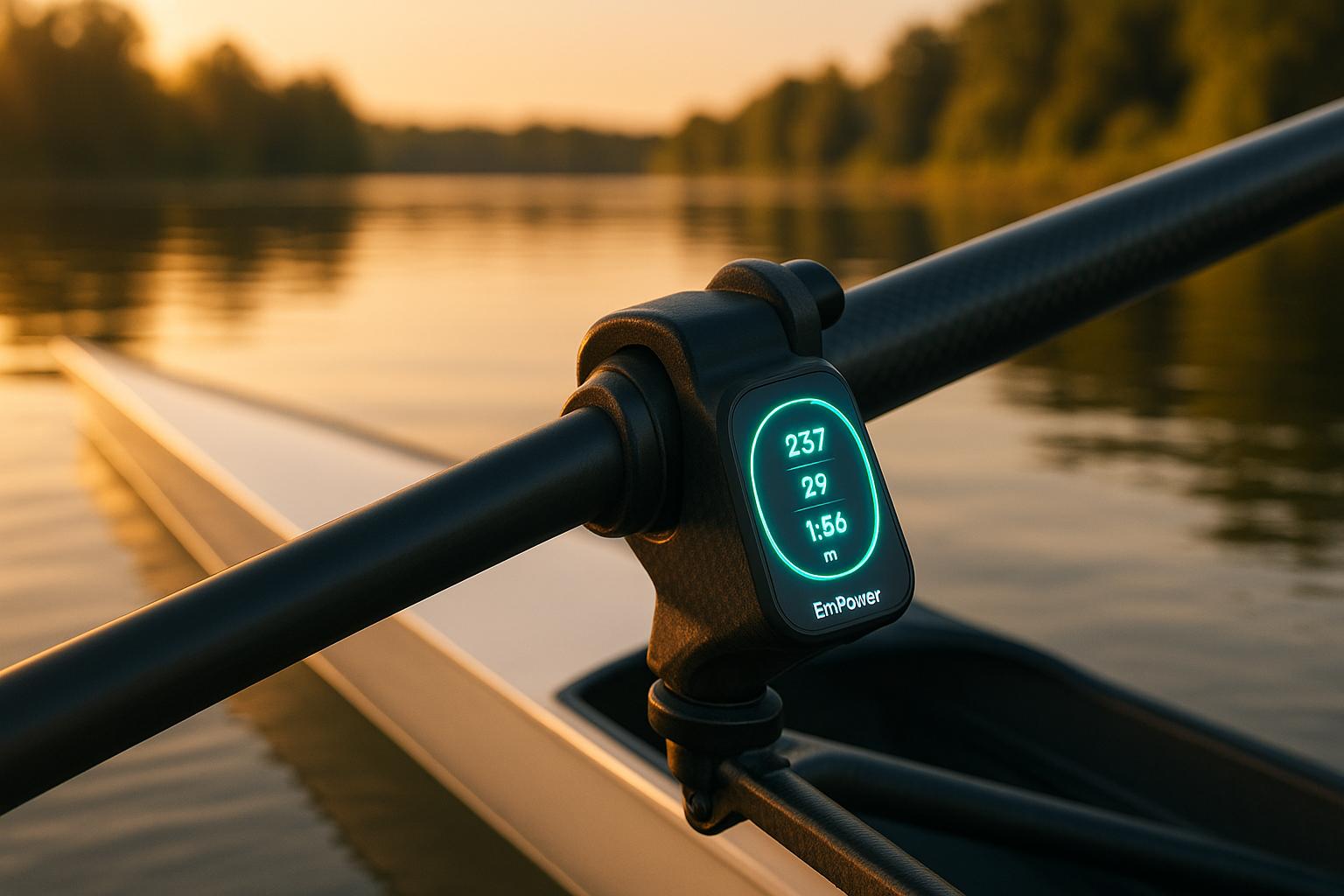
EmPower Oarlock: Features and Benefits
The EmPower Oarlock is a rowing tool that replaces traditional coaching methods by delivering real-time data on stroke mechanics, power output, and blade angles. Unlike conventional approaches that rely on visual observations and post-session reviews, this device provides instant feedback, helping rowers fine-tune their technique during workouts. It tracks up to 13 key metrics per stroke, ensuring precise adjustments and measurable progress.
Key takeaways:
- Real-time feedback: Immediate stroke-by-stroke data for on-the-spot corrections.
- Data accuracy: Tracks metrics like catch angle, peak force, and power output.
- Training optimization: Sets measurable goals for endurance and power.
- Injury prevention: Highlights harmful patterns to reduce strain and overuse injuries.
- Cost: Priced at $599, aimed at serious athletes and teams.
While the EmPower Oarlock offers a data-driven approach, traditional methods focus on coaching expertise and sensory feedback. Both have their strengths, but the choice depends on your goals, budget, and preference for technology in training.
Introducing the Empower Oarlock
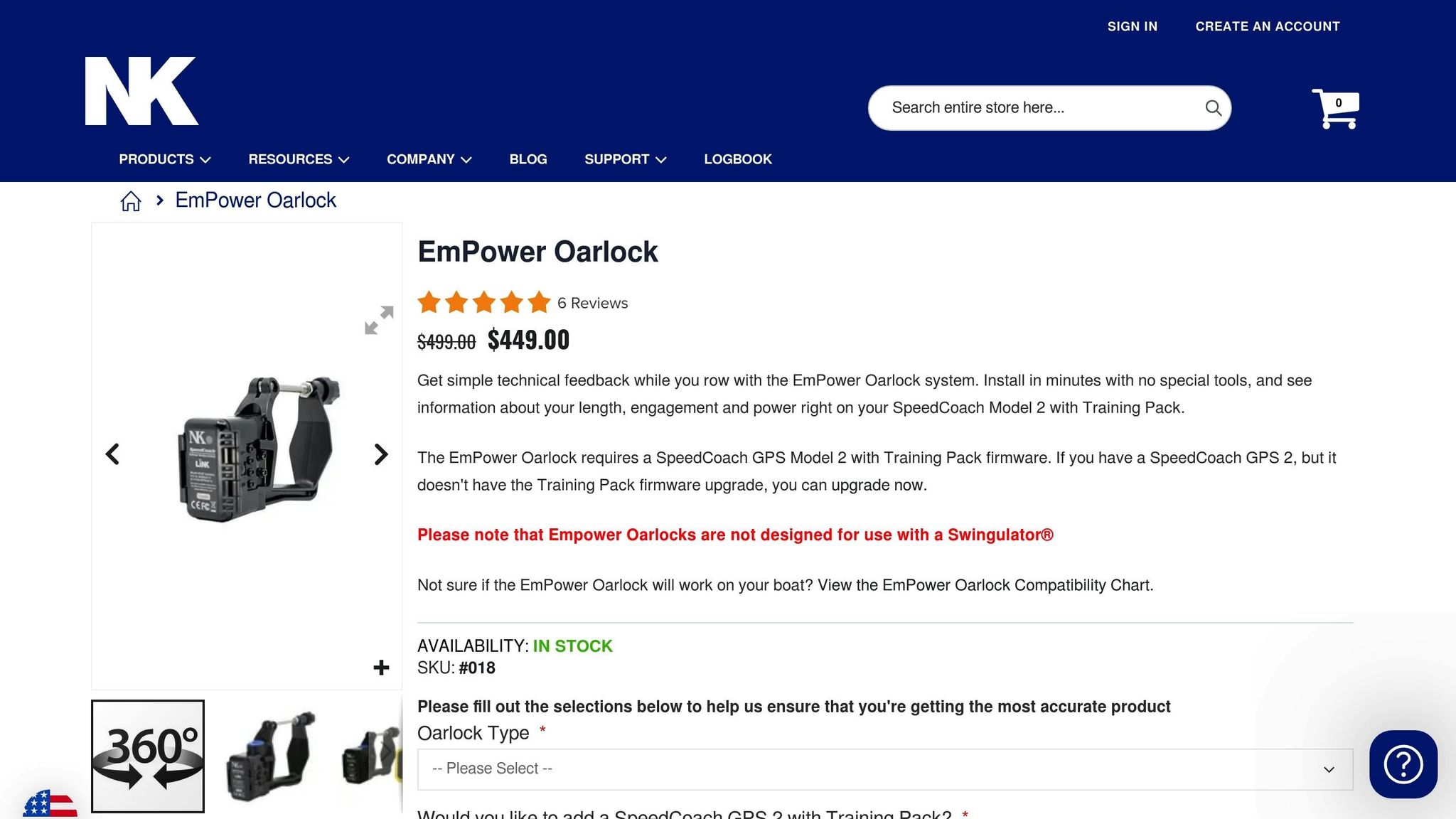
1. EmPower Oarlock
The EmPower Oarlock by Nielsen-Kellerman transforms a standard oarlock into a sophisticated, data-gathering tool. It’s designed to replace your existing oarlock without requiring any special tools or permanent modifications to your boat. This makes it a practical option for both individual rowers and team programs looking to elevate their training sessions.
Real-Time Feedback
With the EmPower Oarlock, you get stroke-by-stroke feedback sent straight to your SpeedCoach GPS 2 screen during every session. This real-time data lets you make immediate adjustments to your technique. The system tracks up to thirteen different metrics per stroke, giving rowers the ability to focus on specific targets as they row. For instance, if your coach sets a target catch angle of 55 degrees, you can check each stroke to ensure you’re hitting that goal.
"The EmPower Oarlock makes rowing more intellectual, conscious, better control", says Dr. Valery Kleshnev, founder of Bio Row.
This instant feedback eliminates the need for guesswork, allowing rowers to make small but impactful adjustments on the fly. Over time, these micro-adjustments lead to noticeable improvements in performance and technique.
Data Accuracy
The EmPower Oarlock tracks critical stroke metrics like catch and finish angles, slip, wash, peak force, work, and power output with every stroke. This data provides an objective way to assess and refine your technique. For example, a university rowing team used the device to reduce their catch angle variance from 4 degrees to 2 degrees. This improvement in synchronization directly translated into faster speeds on the water, showcasing how precise data can drive meaningful results.
By identifying and correcting technique inconsistencies in real time, the EmPower Oarlock helps rowers achieve greater consistency and efficiency during their sessions.
Training Optimization
The EmPower Oarlock doesn’t just measure performance – it helps optimize training. By quantifying both effort and technique, it enables coaches and athletes to set clear, measurable goals. For example, a coach might assign a workout where athletes maintain 150–175 watts for 20 minutes. This data-driven approach ensures consistent, targeted training sessions, whether the focus is on endurance or power.
The device integrates seamlessly with NK Sports‘ Performance Measurement Ecosystem, allowing data to be streamed to the cloud for real-time analysis or detailed post-session reviews using the LiNK Logbook. Volker Nolte, Assistant Professor of Biomechanics and Head Rowing Coach at the University of Western Ontario, highlights how the system’s simplicity and immediate feedback make it a game-changer for training effectiveness.
Injury Prevention
Beyond enhancing performance, the EmPower Oarlock also plays a role in injury prevention. By providing detailed insights into stroke mechanics, it helps rowers avoid excessive strain or uneven loading – common contributors to overuse injuries. Metrics like peak force and its timing within the stroke allow athletes and coaches to spot potentially harmful patterns early on.
Better stroke mechanics, reinforced by continuous feedback, reduce unnecessary stress on joints and muscles, particularly during high-intensity workouts. At a price point of around $599, the EmPower Oarlock is positioned as a premium tool for dedicated rowers and competitive teams who want to train smarter and safer.
2. Standard Rowing Methods (Without Smart Equipment)
Traditional rowing training relies on time-tested techniques. These methods, while lacking the precision of modern technology, have been the backbone of rowing programs for decades. They focus on developing skills and performance through observation, experience, and consistent practice.
Real-Time Feedback
In traditional rowing, feedback comes largely from coaches stationed on the dock, in motorized launch boats, or using megaphones to communicate with athletes. Rowers also depend on sensory feedback – how the water feels, the movement of the boat, and their own physical sensations. Over time, experienced athletes develop a natural sense of timing, rhythm, and power application.
Video analysis is often used to review sessions after practice. While this delayed feedback helps identify technical flaws, any corrections must wait until the next session. This approach highlights the contrast with the instant data provided by smart rowing equipment.
Data Accuracy
Performance in traditional rowing is tracked using basic tools like stopwatches and stroke rate counters. Coaches measure split times, stroke rates, and distances during training to evaluate progress.
Technique evaluation relies heavily on visual observation. Coaches identify issues such as rushed slides, uneven blade work, or early catches by watching athletes closely. While seasoned coaches are adept at spotting these problems, this method is inherently less precise than data-driven analysis.
After each workout, athletes and coaches review times and compare them to previous sessions or goals. Rowers also maintain training logs, noting details like weather conditions, workout intensity, and their own perceptions of the session. Although these metrics are less detailed, they still provide valuable guidance for improving performance.
Training Optimization
Traditional training programs are built on established periodization models that have guided competitive rowing for years. Coaches design workouts based on tried-and-true principles, adjusting intensity and volume to align with race schedules and individual athlete needs. Effort levels are often determined by perceived exertion and the coach’s judgment.
Terms like "steady state", "race pace", and "sprint pieces" are commonly used to describe training intensities, rather than relying on specific metrics like wattage or force output. Boat speed and split times remain the primary indicators of performance, with coaches comparing results across different conditions and lineups to track improvement.
Injury Prevention
Preventing injuries in traditional rowing focuses on teaching proper technique and allowing athletes to develop their skills gradually. Coaches emphasize correct movement patterns and monitor athletes for signs of poor form that could lead to overuse injuries.
Adjustments to training are based on visual observations and feedback from rowers. Strength and conditioning routines, often tailored to rowing, complement on-water sessions. These programs aim to build fitness and prevent injuries but typically don’t include the precise load tracking that modern equipment can provide.
Pros and Cons
When it comes to rowing, both the EmPower Oarlock and traditional methods bring their own set of strengths and challenges. Deciding between them often comes down to what aligns best with a rower’s or coach’s goals, resources, and preferences. Here’s a closer look at how they compare, based on their features and impact on performance.
The EmPower Oarlock stands out for its ability to provide immediate, stroke-by-stroke metrics. This can help identify inefficiencies quickly, making it a powerful tool for fine-tuning technique. However, it does come with a steeper price tag upfront, requires users to interpret data effectively, and demands attention to battery life and routine upkeep.
On the other hand, traditional methods rely heavily on the expertise of coaches and post-session reviews. These approaches encourage athletes to develop a natural feel for boat movement and environmental conditions. While feedback isn’t instant, it allows for a more intuitive learning process. The downside is that technical corrections may take longer to implement due to delayed feedback.
Here’s a side-by-side comparison to break it down further:
| Aspect | EmPower Oarlock | Traditional Methods |
|---|---|---|
| Real-time feedback | Instant stroke-level metrics | Based on coach observation and feel |
| Data | Detailed and precise metrics | Basic timing and visual evaluation |
| Cost | Higher initial cost | Lower equipment expenses |
| Learning curve | Requires data interpretation | Relies on coaching expertise |
| Technical reliance | Device maintenance required | Minimal technical dependencies |
| Injury prevention | Monitors load and technique | Corrects form through experience |
| Training adjustments | Data-driven changes | Intuition-based modifications |
| Progress tracking | Objective, measurable metrics | Subjective evaluations |
Ultimately, the decision comes down to a mix of factors: training goals, budget, and coaching philosophy. Both methods offer distinct benefits, making them suitable for different rowing programs and individual needs.
Conclusion
The EmPower Oarlock delivers a new level of insight, using data to tackle long-standing challenges in rowing. Its real-time feedback system has the potential to reshape how athletes train and refine their technique.
For competitive rowers and dedicated athletes, this device offers a clear edge. The instant feedback allows for quicker technique adjustments and more focused training sessions, potentially cutting down the time it takes to see noticeable improvements – something that might otherwise take months with traditional methods. The investment can feel justified when the results are measurable and impactful.
Coaches also benefit greatly. With access to objective data, they can make precise adjustments to technique and tailor training loads more effectively. Instead of relying solely on visual observations, they can use specific metrics to guide decisions and show athletes clear evidence of their progress.
That said, recreational rowers might find the device less appealing. The detailed data could feel overwhelming, and the cost might outweigh the benefits for those who row casually. Traditional coaching methods, especially with skilled coaches, still provide excellent results and might be a better fit for this group.
Ultimately, the decision comes down to aligning with your rowing goals. If performance improvement is a top priority, whether for competition or coaching, the EmPower Oarlock offers clear benefits. For those ready to invest in smart rowing technology, the data it provides can translate into real gains in both technique and overall performance.
If you’re exploring other rowing tech options, platforms like RowingList.com can guide you toward tools and services that complement devices like the EmPower Oarlock. From coaching programs to training apps that sync with wearable trackers, there are plenty of resources to enhance your rowing journey.
FAQs
How does the EmPower Oarlock help improve rowing technique and performance compared to traditional methods?
The EmPower Oarlock revolutionizes rowing training by offering real-time insights into key metrics like stroke angles, force, and power. With this data at their fingertips, rowers can instantly adjust their technique, leading to more efficient and effective strokes.
Unlike traditional coaching methods that often rely on subjective observations, the EmPower Oarlock delivers precise, measurable feedback to refine performance. By helping athletes fine-tune their technique and optimize training zones, it paves the way for faster boat speeds and greater efficiency. It’s a must-have tool for anyone looking to take their rowing to the next level.
What does the EmPower Oarlock measure, and how can these insights improve your rowing performance?
The EmPower Oarlock tracks essential metrics such as power, work per stroke, and catch and finish angles, giving you a detailed breakdown of your rowing technique. With these insights, rowers can pinpoint inefficiencies, fine-tune their strokes, and train more effectively within their desired performance zones.
This kind of data-driven feedback allows athletes to enhance their performance, avoid overtraining, and work toward their rowing goals with greater precision. Whether you’re gearing up for a competition or focusing on overall fitness, the EmPower Oarlock provides actionable insights to make your training sessions more effective.
Is the EmPower Oarlock designed for all rowers, or just for competitive athletes?
The EmPower Oarlock is a game-changer for rowers at every level, whether you’re a weekend enthusiast or a serious competitor. By providing real-time data, it helps you fine-tune your technique, boost your performance, and tackle common rowing hurdles. Whether your goal is to enjoy the sport or prepare for a big race, this tool makes the journey more effective and rewarding.

